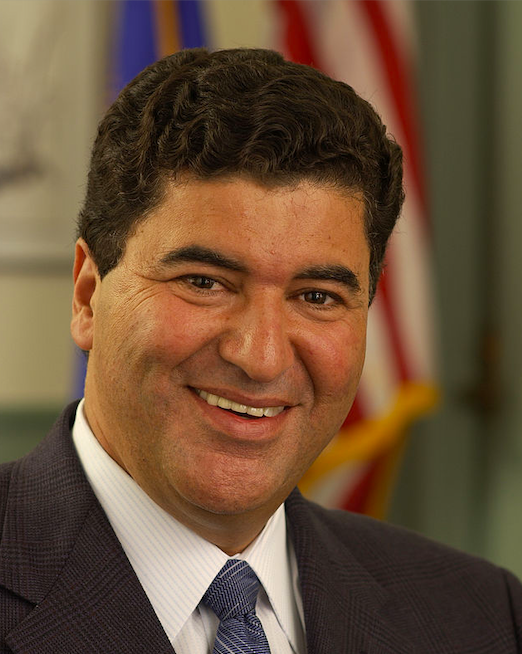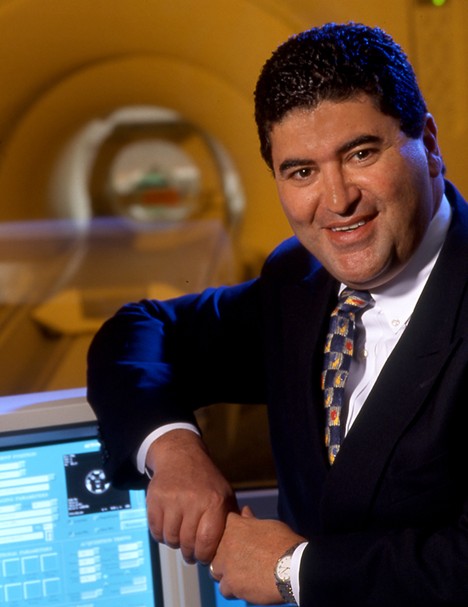Pathbreakers of Arab America—Elias Zerhouni

By: John Mason / Arab America Contributing Writer
This is the eighty-third in Arab America’s series on American pathbreakers of Arab descent. The series features personalities from various fields, including entertainment, business, sports, science, the arts, academia, journalism, and politics. Our eighty-third pathbreaker, Dr. Elias Zerhouni, is an Algerian-born American scientist, radiologist, biomedical engineer, entrepreneur, and pharmaceutical industry executive who served as the 15th Director of the National Institutes of Health. He is an outside-of-the-box thinker and has contributed significantly to essential health improvements and breakthroughs.
Dr. Zerhouni, a world-renowned leader in radiology and medicine, excelled in clinical, scientific, and administrative leadership of key medical and health advances
Elias Zerhouni was born on April 12, 1951, in a small city of Nedroma in Tlemcen Province, in the North African country of Algeria, near the western border with Morocco. He grew up during the Algerian War of Independence against the French from 1954 to 1962. Elias’ father was a math professor at the University of Algiers. Because of the War, Zerhouni often had to miss school because of the ongoing conflict between France and the Algerian National Liberation Front. Zerhouni earned his medical degree from the University of Algiers School of Medicine in 1975. He met his future wife, Nadia Azza, in his native country, where both were competitive swimmers. They have two sons and one daughter.
In 1975, Zerhouni and Nadia came to Baltimore, purportedly with just a few hundred dollars and their medical degrees from Algeria. ”We had little money, no family and no friends,” Dr. Zerhouni recalled many decades later during the White House ceremony where he was appointed 15th Director of the National Institutes of Health. The couple was supposed to stay in Baltimore for just a few months while Elias trained as a radiologist at Johns Hopkins before returning to Algiers. Elias’ initial residency, sponsored by the Algerian government, became a formal residency program. He subsequently held positions within the radiology department, including chief resident and assistant professor.
From 1981 to 1985, according to Wikipedia’s Series on Arab Americans, Zerhouni became vice chair of the Department of Radiology at Eastern Virginia Medical School and its affiliated DePaul Hospital. In 1985, Zerhouni returned to Johns Hopkins as co-director of body CT and MRI and was promoted to associate professor. He was appointed director of the MRI division in 1988 and then promoted to full professor in 1992. In 1995, he also became a professor of biomedical engineering at Hopkins. In 1996, Zerhouni was named chair of the radiology department at Johns Hopkins. Zerhouni was appointed executive vice dean of the Johns Hopkins School of Medicine in 1996, serving as vice dean for Clinical Affairs and president of the Clinical Practice Association (1996-1999) and vice dean for Research (1999–2002).
In April 2002, Zerhouni was appointed Director of the National Institutes of Health (NIH) by President George W. Bush, confirmed by the Senate, and served until October 2008. He is credited with being the first immigrant to serve as NIH Director. During his tenure, the agency made several critical improvements in the nation’s premier health policies and programs. A few of these include: establishing the NIH Roadmap for Medical Research; passage of the NIH Reform Act of 2006; establishing an NIH-wide research initiative on obesity; supporting research related to women’s health and the development of a vaccine against human papillomavirus; and creating the NIH Director’s Pioneer Award Program and the NIH Director’s New Innovator Award in 2007.

In 2009, Zerhouni was one of the first presidential science envoys, under the Obama administration, working to foster scientific and technological collaboration with other nations. He was a senior fellow for the Bill and Melinda Gates Foundation from 2009 to 2010, and from January 2011 until his retirement on June 30, 2018, he was President of Global Research and Development at the pharmaceutical company Sanofi. In October 2020, Zerhouni co-founded ModeX Therapeutics, a privately held biotechnology company developing multi-specific immune therapies for cancer and infectious diseases.
Zerhouni is credited with developing imaging methods for diagnosing cancer and cardiovascular disease
Dr. Zerhouni is described as one of the world’s premier experts in magnetic resonance imaging. He integrated his university and corporate technical careers, developing state-of-the-art techniques used in medical imaging and radiation therapy. He is also known for his co-invention of an image-guided breast biopsy method for diagnosing breast cancer, which led to the creation of Biopsys Medical, acquired by Johnson & Johnson in 1997. He also established American Radiology Services, an expansion of Johns Hopkins outpatient radiology.
Zerhouni served on the National Cancer Institute’s Board of Scientific Advisors (1998-2002), was a consultant to the White House under President Ronald Reagan (1985), and was a consultant to the World Health Organization (1988). Not to be outdone by the Americans, in 2008, French President Nicolas Sarkozy awarded Zerhouni the Knight of the Legion of Honour, France’s highest order of merit, for his role in fostering collaboration between the National Institutes of Health and the Pasteur Institute.
Zerhouni advanced the diagnosis of critical health conditions, such as his pioneering magnetic tagging, a non-invasive method of using MRI to track the motions of the heart in three dimensions. He is also renowned for refining an imaging technique called computed tomographic (CT) densitometry that helps discriminate between non-cancerous and cancerous nodules in the lungs. His full contribution to radiology and medicine is too numerous to list here.
Zerhouni’s specific contributions to the NIH during his tenure include: Reauthorization of renewed confidence in NIH; initiation of the NIH Roadmap for Medical Research; development of a new office to improve funding of cross-NIH initiatives; establishment of an NIH-wide research initiative to address the obesity epidemic; support of NIH’s Neuroscience Blueprint, namely, to treat mental illness, neurological disorders, and a range of behavioral disorders; giving priority to health disparities across the nation; and ensuring public access to NIH-funded research results.
A story of Zerhouni’s sense of modesty throughout his career is worth telling: “In December 2001, an official with the George W. Bush administration telephoned Elias Zerhouni in his Johns Hopkins office. Would Zerhouni like to be director of the National Institutes of Health? When I was called, I thought it was a mistake,” Zerhouni said. “I thought they called the wrong person.” He hadn’t gone to an Ivy League school, and his background was in radiology, not basic science, as was traditional for the job. What’s more, it was right after 9/11, and he is Muslim.” So far, Zerhouni is the only immigrant to lead an agency thought by many to be the crown jewel of the federal government.
In his 2025 memoir, ‘In Disease Knows No Politics: The Immigrant Journey and Lessons of Dr. Elias Zerhouni,’ Zerhouni traces his eventful life from childhood to present, highlighting his talent for big-picture thinking and his determination to follow the science, not the whims of politicians. He also wrote, “As director, I believed the agency’s mission was sacred. The NIH needed to be at the service of all Americans, regardless of their political preferences, race, sexual orientation, religion, or gender.” In the foreword to the book, former Johns Hopkins University President William Brody praises Zerhouni as a “once-in-a-generation talent” and adds, “Where others see problems, he sees solutions.”

In the last chapter of the book, Zerhouni shares what he learned about the U.S. health care system in his journey from academia to government to industry and expresses dismay that the American health care system “has become captive to powerful special interests, supported by, in my view, ill-advised partisan policies.” He outlines some of the challenges and proposes some remedies.
Zerhouni, an optimist by nature, believes that publicly funded science and technology will remain strong in the United States. “There is bipartisan support for the National Institutes of Health, and for science and technology in general,” he says. While the present government has a different view of its role in health and human services, we would do well to follow Dr. Zerhouni’s sense of optimism, if only because the physical and mental health of Americans is paramount.
Sources:
–“Elias Zerhouni,” Wikipedia Series on Arab Americans, 2025
–“Elias A. Zerhouni, M.D., Director, National Institutes of Health, May 2, 2002 – October 31, 2008,” The NIH Almanac, 2008
–“Immigrant of the Day: ELIAS ZERHOUNI (Algeria),” ‘Immigration Prof,’ 4/24/2008
–“Man in the News; From Algeria to a Dream — Elias Adam Zerhouni,” New York Times, 3/27/2002
–“A Sacred Mission- Elias Zerhouni,” Johns Hopkins University, 2/7/2025
John Mason, Ph.D., focuses on Arab culture, society, and history and is the author of LEFT-HANDED IN AN ISLAMIC WORLD: An Anthropologist’s Journey into the Middle East, New Academia Publishing, 2017. He has taught at the University of Libya, Benghazi, Rennselaer Polytechnic Institute in New York, and the American University in Cairo; John served with the United Nations in Tripoli, Libya, and consulted extensively on socioeconomic and political development for USAID and the World Bank in 65 countries.
The views and opinions expressed in this article are those of the author and do not necessarily reflect the position of Arab America. The reproduction of this article is permissible with proper credit to Arab America and the author.
Want more articles like this? Sign up for our e-newsletter!
Check out our blog here!








